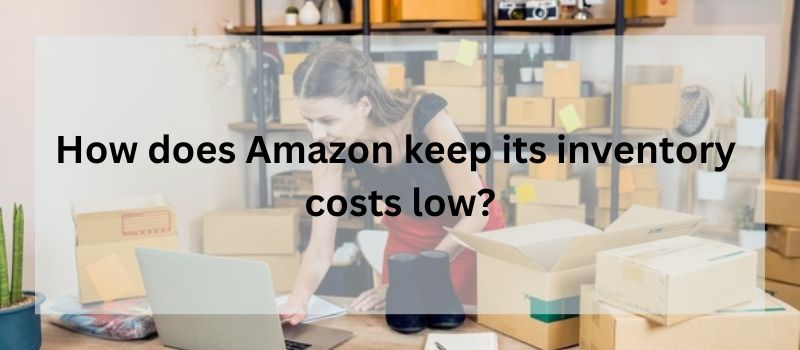As an avid Amazon customer, I’m always amazed at how quickly my orders arrive—sometimes just one or two days after I click buy! And the items are often cheaper than what I’d pay at a brick-and-mortar store.
This got me wondering: How does Amazon keep its inventory costs low? while still offering such great service? After doing some research on Amazon’s operations, three key strategies stood out that allow the e-commerce giant to maximize efficiency.
By leveraging economies of scale, practicing just-in-time inventory management, and enabling third-party seller fulfillment, Amazon has mastered the art of keeping supply chain expenses to a minimum.
Contents
- 1 How does Amazon keep its inventory costs low?
- 2 Leveraging Economies of Scale
- 3 Just-In-Time Inventory Management
- 4 Third-Party Seller Fulfillment
- 5 Innovations in Storage and Distribution
- 6 FAQs
- 6.1 Q1: How does Amazon manage inventory for millions of products?
- 6.2 Q2: Does Amazon buy inventory in bulk to reduce costs?
- 6.3 Q3: Why is Fulfillment by Amazon (FBA) key for Amazon?
- 6.4 Q4: How will drones and robots help Amazon’s inventory costs?
- 6.5 Q5: How does Amazon offer speedy, free delivery?
- 6.6 Q6: What inventory lessons can other retailers learn from Amazon?
- 7 Conclusion
How does Amazon keep its inventory costs low?
Amazon keeps inventory costs low through economies of scale, purchasing high volumes to secure discounts. Sophisticated forecasting models allow just-in-time practices to closely align supply and demand.
Third-party seller fulfillment offloads risks, while innovations in warehouse automation and delivery remove labor expenses. Combined, these strategies minimize overhead and carrying costs even with massive throughputs, supporting Amazon’s aggressive pricing.
The company’s supply chain mastery translates into consumer savings.

Leveraging Economies of Scale
Due to its massive size and sales volumes, Amazon can take advantage of cost savings that come from operating on an enormous scale. The company employs tactics like bulk purchasing and sophisticated global supply chain coordination to reduce inventory overhead.
For example, because Amazon buys products in such huge quantities, it can pressure suppliers to offer lower per unit prices. The materials and components that go into making Kindle e-readers, Echo smart speakers, and other Amazon devices certainly don’t cost the company as much as smaller buyers would pay.
Amazon likely saves at least 15-20% compared to rival electronics makers who don’t move as much volume. Additionally, Amazon has fine-tuned fulfillment down to a science. The company uses advanced software to optimize global supply chains and intelligently route inventory to where it’s needed most.
Highly automated fulfillment centers—like the million-square-foot facility near me in New Jersey—leverage robotics and technology to efficiently pick, pack, and ship customer orders. Superior logistics management surely allows Amazon to handle greater order volumes at a decreased cost per order.
Just-In-Time Inventory Management
In addition to supply chain scale, Amazon has implemented just-in-time principles to eliminate waste and cut inventory carrying costs. Sophisticated demand forecasting, lean operations, and real-time visibility give the company tremendous precision.
For example, Amazon deploys machine learning models to predict product demand and ensure distribution centers have just enough inventory to meet sales. But not too much to risk losses from overstock or spoilage. This level of precision allows Amazon to avoid tying up cash in excess inventory.
Applying lean manufacturing guidelines also boosts efficiency. Amazon diligently tracks cycle times, quality, and waste throughout fulfillment workflows. By striving to create flow and eliminate bottlenecks, the company speeds up throughput while reducing expenses.
Finally, Amazon fba experts maintains real-time oversight of inventory across its vast network. The company developed proprietary supply chain technology offering visibility into inventory levels, orders, and transportation. This allows Amazon to respond instantly to shortages or surpluses and prevent costly backorders or overstocks.
You might wonder how Amazon handles the complexities of food inventories with its Whole Foods subsidiary. Due to the perishable nature of groceries, forecasts and stock monitoring are even more critical.
Thankfully Amazon’s analytics excellence equips Whole Foods to minimize spoilage and seamlessly stock just enough fresh produce, dairy, meat and more to satisfy neighborhood demand.

Third-Party Seller Fulfillment
A core part of Amazon’s strategy to offload inventory costs involves enabling third-party sellers. Amazon opened its Marketplace years ago so outside vendors could list products to complement Amazon’s own catalog. This instantly expanded options for customers without Amazon handling fulfillment.
Today, over 50% of units sold on Amazon come from third-party sellers, although Amazon still earns profits. The Amazon Marketplace contains millions of offers from small businesses and individual entrepreneurs. However, inventory sits with the sellers until a purchase occurs.
Many sellers also leverage Fulfillment by Amazon (FBA) to hand off warehousing and shipping duties. Sellers send products in bulk to Amazon’s fulfillment centers, then Amazon handles storage, packing, and delivery. As an amazon fba expert It’s a win-win since sellers gain Amazon’s world-class logistics, while Amazon earns fees without asset risk.
In fact, Amazon even provides incentive for sellers to use FBA instead of self-fulfillment. Listings with FBA are eligible for Prime and usually rank higher in search results. Sellers also gain visibility into inventory through the Seller Central dashboard. Leveraging seller fulfillment has proven hugely effective at controlling Amazon’s expenses.

Innovations in Storage and Distribution
Even with these inventory optimization levers in place, Amazon continues aggressively innovating on storage and distribution. As an amazon fba expert Breakthroughs on the horizon like warehouse robotics, route planning algorithms, and drone delivery will likely expand Amazon’s cost advantage even further.
Within fulfillment centers, Amazon deploys advanced robotic systems to assist human workers with various tasks like lifting heavy pallets or transporting shelves. Engineers are rushing to develop new warehouse bots to handle more and more steps in the fulfillment sequence without ever tiring or calling in sick.
Sophisticated route planning software helps Amazon map out the most efficient routes for delivery vehicles. Machine learning algorithms ingest data on traffic patterns, weather delays, and other variables to optimize each mile on the road. Reducing fuel costs and shaving mileage ultimately supports slimmer bottom lines.
Who could forget Amazon’s audacious drone delivery idea? Though still in testing, Prime Air drones promise quick dispatch from local warehouses straight to doorsteps. Drone delivery removes costs associated with last mile human drivers almost entirely. Initial trials focused on lightweight products like household essentials or electronics. But eventually the potential exists for drones to transport bulkier items too.
FAQs
Q1: How does Amazon manage inventory for millions of products?
Amazon uses cutting-edge forecasting models, lean operations, and real-time monitoring to precisely match supply and demand. This allows Amazon to keep just enough inventory on-hand to meet sales demand.
Q2: Does Amazon buy inventory in bulk to reduce costs?
Yes, by purchasing products in massive volumes Amazon can leverage economies of scale to lower per unit costs from suppliers by 15-20% or more.
Q3: Why is Fulfillment by Amazon (FBA) key for Amazon?
FBA allows Amazon to handle shipping for third-party sellers while earning fees, expanding Prime eligibility without asset risk.
Q4: How will drones and robots help Amazon’s inventory costs?
Emerging warehouse automation and future drone delivery remove significant fulfillment expenses associated with human labor.
Q5: How does Amazon offer speedy, free delivery?
Inventory optimization and distribution innovations like route planning software support fast fulfillment across Amazon’s network at minimal cost.
Q6: What inventory lessons can other retailers learn from Amazon?
Amazon’s use of scale, precision forecasting, and embracing new technologies provide a blueprint for inventory excellence.
Conclusion
Amazon’s inventory management prowess relies on scale, precision, and innovation. Mastering these three areas has been key not only to Amazon’s retail dominance but also its strong financial health. Other companies should look to emulate Amazon’s playbook if they hope to compete in e-commerce today and in the future.
Of course, consumers like me will continue benefiting from Amazon’s relentless efforts to lower expenses and offer unbeatable convenience. As an amazon fba expert I can’t think of another retailer that so consistently delights its customers while keeping shareholders happy.
So next time my latest Amazon order shows up in record time, As an amazon fba expert I’ll be reminded of the operational excellence that made fast, free delivery possible!
Ready to sell on Amazon? Our guided launch program handles everything from product sourcing to optimization, helping sellers succeed in the Marketplace. Get Started Now with As an amazon fba expert!
Read More:



